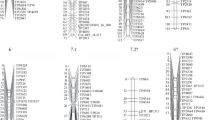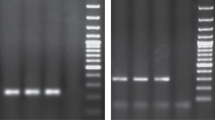Abstract
The paper provides an overview of foreign and Russian studies of the genus Ribes genome by means of DNA markers. A list of methods for DNA extraction from currants is given. Studies on the use of different types of DNA markers (RAPD, AFLP, ISSR, SSR) for genetic diversity, identification of varieties, molecular phylogeny, and systematics are represented. In the works of various research teams, a high level of polymorphism revealed by microsatellite markers is shown. Examples and prospects for their use in development of identification tools, validations of pedigrees, and collection management are represented. The paper describes genetic maps of blackcurrant developed by means of AFLP, SSR, SNP DNA markers. A list of QTL (quantitative trait loci) localized on genetic maps is represented. The published techniques for marker-assisted selection are described: DNA markers of gene Се and gene Р of blackcurrant resistance to gall mite and DNA markers of green and black color of berries. The method of gene Ce detection improved by the authors is described. Blackcurrant is the most widely studied by means of DNA markers crop of genus Ribes L. The prospects for further development of genome studies of currants and the possibilities that these studies will open for further human-directed improvement of these economically important crops are considered.


Similar content being viewed by others
REFERENCES
Knyazev, S.D. and Ogol’tsova, T.P., Selektsiya smorodiny chernoi na sovremennom etape (Selection of Black Currant: State-of-the-Art), Orel: Orel Gos. Agrar. Univ., 2004.
Hummer, K.E. and Barney, D., Currants, HortTechnology, 2002, vol. 12, no. 3, pp. 377—387.
Malinovskii, B., 2017. https://propozitsiya.com/krasnaya-smorodina-priznana-samoy-rentabelnoy-nishevoy-yagodoy doi 10.1051/fruits/2011049 www.fruits-journal.org.
Pomologiya (Pomology), vol 4: Smorodina, Kryzhovnik (Currant, Gooseberry), Sedov, E.N., Ed., Orel: Vserossiiskii Nauchno-Issledovatel’skii Institut Selektsii Plodovykh Kul’tur, 2009.
Bauer, R., “True breeding” for combined resistance to leaf, bud and shoot diseases, Jugosl. Vocarstvo, 1973, vol. 7, nos. 25—26, pp. 17—19.
Chiche, J., Brown, S.C., Leclerc, J.-L., et al., Genome size, heterochromatin organization and ribosomal gene mapping in four species of Ribes, Can. J. Bot., 2003, vol. 81, pp. 1049—1057. https://doi.org/10.1139/b03-088
Messinger, W., Liston, A., and Hummer, K., Ribes phylogeny as indicated by restriction-site polymorphisms of PCR-amplified chloroplast DNA, Plant Syst. Evol., 1999, vol. 217, pp. 185—195.
Doyle, J.J. and Doyle, J.L., A rapid DNA isolation procedure for small quantities of fresh leaf tissue, Phytochem. Bull., 1987, vol. 19, pp. 11—15.
Rowland, L.J. and Nguyen, B.I.N.H., Use of polyethylene glycol for purification of DNA from leaf tissue of woody plants, BioTechniques, 1993, vol. 14(5), pp. 734—736.
Lanham, P.G. and Brennan, R.M., Genetic characterization of gooseberry (Ribes grossularia subgenus Grossularia) germplasm using RAPD, ISSR and AFLP markers, J. Hortic. Sci. Biotechnol., 1999, vol. 74, pp. 361—366. https://doi.org/10.1080/14620316.1999.11511122
Brennan, R., Jorgensen, L., Woodhead, M., et al., Development and characterization of SSR markers in Ribes species, Mol. Ecol., 2002, no. 2(3), pp. 327—330. https://doi.org/10.1046/j.1471-8286.2002.00233.x
Russell, J.R., Bayer, M., Booth, C., et al., Identification, utilisation and mapping of novel transcriptome-based markers from blackcurrant (Ribes nigrum), BMC Plant Biol., 2011, no. 11(1), p. 147. https://doi.org/10.1186/1471-2229-11-147.
Milligan, B.G., Plant DNA isolation, in Molecular Genetics of Populations: Molecular Analysis of Population: a Practical Approach, Oxford, UK: IRL Press, 1992, pp. 59—68.
Weigend, M., Flowering plants: eudiocots, in Families and Genera of Vascular Plants, 2007, vol. 9, pp. 168—176.
Struwe, L.M., Thiv, J.W., Kadereit, A.S.-R., et al., Saccifolium an endemic of Sierra de La Neblina on the Brazillian-Venezuelan frontier is related to a temperate alpine lineage of Gentianaceae, Harvard Pap. Bot., 1998, vol. 3, pp. 199—214.
Palmieri, L., Grando, M.S., Sordo, M., et al., Establishment of molecular markers for germplasm management in a worldwide provenance Ribes spp. collection, Plant Omics, 2013, vol. 6(3), pp. 165—174.
Puchooa, D., A simple, rapid and efficient method for the extraction of genomic DNA from lychee (Litchinensis Sonn.), Afr. J. Biotechnol., 2004, vol. 3, no. 4, pp. 253—255. https://doi.org/10.5897/AJB2004.000-2046
Doyle, J.J. and Doyle, J.L., Isolation of plant DNA from fresh tissue, Focus, 1990, vol. 12, pp. 13—15.
Lanham, P., Brennan, R.M., Hackett, C., et al., RAPD fingerprinting of blackcurrant (Ribes nigrum L.) cultivars, Theor. Appl. Genetics., 1995, vol. 90, pp. 166—172. https://doi.org/10.1007/BF00222198
Lanham, P.G., Korycinska, A., and Brennan, M., Genetic diversity within a secondary gene pool for Ribes nigrum L. revealed by RAPD and ISSR markers, J. Hortic. Sci. Biotechnol., 2000, vol. 75(4), pp. 371—375. https://doi.org/10.1080/14620316.2000.11511253
Russell, J., Hackett, C., Hedley, P., et al., The use of genotyping by sequencing in blackcurrant (Ribes nigrum): developing high-resolution linkage maps in species without reference genome sequences, Mol. Breed., 2014, vol. 33(4), pp. 835—849. https://doi.org/10.1007/s11032-013-9996-8
Khavkin, E.E., Molecular selection of plants: DNA technology to create new agricultural varieties, S-kh. Biol., 2003, no. 3, pp. 26—41.
Chesnokov, Yu.V., DNA fingerprinting and the analysis of plant genetic diversity, S-kh. Biol., 2005, vol. 40, no. 1, pp. 20—40.
Pikunova, A.V., The use of molecular markers to assess the original breeding material of berry crops, Vestn. Orlov. Gos. Agrar. Univ., 2011, no. 3(30), pp. 29—32.
Vos, P., Hogers, R., Bleeker, M., et al., AFLP: a new technique for DNA fingerprinting, Nucleic Acids Res., vol. 23(21), pp. 4407—4414. https://doi.org/10.1093/nar/23.21.4407
Zietkiewicz, E., Rafalski, A., and Labuda, D., Genome fingerprinting by simple sequence repeat (SSR)-anchored polymerase chain reaction amplification, Genomics, 1994, vol. 20, pp. 176—183. https://doi.org/10.1006/geno.1994.1151
Keller-Przybylkowicz, S., Korbin, M., and Gwozdecki, J., RAPD and ISSR markers of black and green colour of blackcurrant (Ribes nigrum) fruits, J. Fruit Ornamental Plant Res., 2006, vol. 14, pp. 45—52.
Jones, C.J., Edwards, K.J., Castaglione, S., et al., Reproducibility testing of RAPD, AFLP and SSR markers in plants by a network of European laboratories, Mol. Breed., 1997, vol. 3, no. 5, pp. 381—390. https://doi.org/10.1023/A:1009612517139
Kalia, R.K., Rai, M.K., Kalia, S., et al., Microsatellite markers: an overview of the recent progress in plants, Euphytica, 2011, no. 177(3), pp. 309—334. https://doi.org/10.1007/s10681-010-0286-9
http://www.fruitbreeding.co.uk/RibesGenomicsSSRs.asp.
Brennan, R., Jorgensen, L., Hackett, C., et al., The development of a genetic linkage map of blackcurrant (Ribes nigrum L.) and the identification of regions associated with key fruit quality and agronomic traits, Euphytica, 2008, vol. 61, pp. 19—34. https://doi.org/10.1007/s10681-007-9412-8
Cavanna, M., Marinoni, D.T., Beccaro, G.L., et al., Microsatellite-based evaluation of Ribes spp. germplasm, Genome, 2009, vol. 52, no. 10, pp. 839—848. https://doi.org/10.1139/G09-057
Antonius, K., Karhu, S., Kaldm, H., et al., Development of the Northern European Ribes core collection based on a microsatellite (SSR) marker diversity analysis, in Plant Genetic Resources: Characterization and Utilization, 2012, pp. 70—73. https://doi.org/10.1017/S1479262111000980.
Pikunova, A.V., Knyazev, S.D., Bakhotskaya, A.Yu., et al., Polymorphism of microsatellite loci among black currant (Ribes nigrum L.) varieties from the collection of All-Russian Research Institute for Fruit Crops Selection, S-kh. Biol., 2015, vol. 50, no. 1, pp. 46—54. https://doi.org/10.15389/agrobiology.2015.1.46rus
Gaevskii, N.A., Znakomstvo s evolyutsionnoi genetikoi (Knowledge of Evolutionary Genetics), Krasnoyarsk, 2002.
Reim, S., Flachowsky, H., Hanke, M.V., et al., Verifying the parents of the Pillnitzer apple cultivars, Acta Hortic., 2009, vol. 814, pp. 319—323. https://doi.org/10.17660/ActaHortic.2009.814.50
Mezhnina, O.A., Assessment of genetic diversity and the development of methods for the DNA-identification of varieties and species of Fragaria L. and Ribes L., Extended Abstract of Cand. Sci. Dissertation, 2017, p. 25.
Burnes, T.A., Blanchette, R.A., Smith, J.A., et al., Black currant clonal identity and white pine blister rust resistance, HortScience, 2008, vol. 43(1), pp. 200—202.
Rehder, A., Manual of Cultivated Trees and Shrubs, Toronto: MacMillan, 1954.
Keep, E., Interspecific hybridization in Ribes, Genetica, 1962, vol. 33, pp. 1—23.
Coville, F.V. and Britton, N.L., Grossulariaceae, in North American Flora, 1908, vol. 22, pp. 193—225.
Berger, A., A taxonomic review of currants and gooseberries, N.Y. Agric. Exp. Sta. Techn. Bull., 1924, vol. 109, pp. 1—118.
Komarov, V.L., Ribesioideae Engl., in Flora of the (Former) USSR, London: Keter, 1971, vol. 9, pp. 175—208.
Brennan, R.M., Currants and gooseberries, in Temperate Fruit Crop Breeding, Dordrecht: Springer-Verlag, 2008, pp. 177—196.
Janczewski, E., Monograph of the currants Ribes L., Mem. Soc. Phys. Hist. Nat. Geneve, 1907, vol. 35, pp. 199—517.
Sinnott, Q.P., A revision of Ribes L. subg. Grossularia (Mill.) per. Sect. Grossularia (Mill.) Nutt. (Grossulariaceae) in North America, Rhodora, 1985, vol. 87, pp. 189—286.
Eremin, G.V., Isachkin, A.V, Kazakov, I.V., et al., Obshchaya selektsiya i sortovedenie plodovykh i yagodnykh kul’tur (General Selection and Obtaining Varieties of Fruit and Berry Crops), Moscow: Mir, 2004.
Samigullina, N.S., Praktikum po selektsii i sortovyvedeniyu plodovykh i yagodnykh kul’tur: uchebnoe izdanie (A Practical Course in Breeding and Obtaining Varieties of Fruit and Berry Crops: a Textbook), Michurinsk: Michurin. Gos. Univ., 2006.
Schultheis, L.M. and Donoghue, M.J., Molecular phylogeny and biogeography of Ribes (Grossularia) with an emphasis of gooseberry (subg. Grossularia), Syst. Bot., 2004, vol. 29, no. 1, pp. 77—96. https://doi.org/10.1600/036364404772974239
Senters, A.E. and Soltis, D.E., Phylogenetic relationships in Ribes (Grossulariaceae) inferred from ITS sequence data, Taxon, 2003, vol. 52, pp. 51—66.
http://www.ncbi.nlm.nih.gov/nuccore.
Mazeikiene, I., Bendokas, V., Stanys, V., et al., Molecular markers linked to resistance to the gall mite in blackcurrant, Plant Breed., 2012, vol. 131(6), pp. 762—766. https://doi.org/10.1111/j.1439-0523.2012.01995.x
Hackett, C.A., Russell, J., Jorgensen, L., et al., Multi-environment QTL mapping in blackcurrant (Ribes nigrum L.) using mixed models, Theor. Appl. Genet., 2010, vol. 121(8), pp. 1483—1488. https://doi.org/10.1007/s00122-010-1404-8
Ogol’tsova, T.P., Selektsiya chernoi smorodiny—proshloe, nastoyashchee, budushchee, (Blackcurrant Selection—Past, Present, Future), Tula: Priokskoe Knizhnoe Izd., 1992.
Keep, E., Breeding for resistance to American gooseberry mildew, Sphaerotheca mors-uvae, in the gooseberry (Ribes grossularia), Ann. Appl. Biol., 1974, vol. 76(1). 131—135. https://doi.org/10.1111/j.1744-7348.1974.tb01363.x
Collard, B.C., Marker-assisted selection: an approach for precision plant breeding in the twenty-first century, Philos. Trans. R. Soc., B, 2008, vol. 363, pp. 557—572. https://doi.org/10.1098/rstb.2007.2170
Francia, E., Marker assisted selection in crop plants, Plant Cell. Tissue Organ Cult., 2005, vol. 82, pp. 317—342. https://doi.org/10.1007/s11240-005-2387-z
Brennan, R., Jorgensen, L., Gordon, S.L., et al., The development of a PCR-based marker linked to resistance to the blackcurrant gall mite (Cecidophyopsis ribis Acari: Eriophyidae), Theor. Appl. Genet., 2009, vol. 118, pp. 205—211. https://doi.org/10.1007/s00122-008-0889-x
Anderson, M.M., Resistance to gall mite (Phytoptus ribes Nal.) in the Eucorcosma section of Ribes, Euphytica, 1971, vol. 20, pp. 422—426.
Knight, R.L., Transference of resistance to black currant gall mite Cecidophyopsis ribis from gooseberry to black currant, Ann. Appl. Biol., 1974, vol. 76, pp. 123—130. https://doi.org/10.1111/j.1744-7348.1974.tb01362.x
Mazeikiene, I., Bendokas, V., Baniulis, D., et al., Genetic background of resistance to gall mite in Ribes species, Agric. Food Sci., 2017, vol. 26(2), pp. 111—117. https://doi.org/10.23986/afsci.59410
Pikunova, A.V., Genetic diversity assessment in the source and breeding material of berry cultures using molecular markers, Cand. Sci. (Biol.) Dissertation, 2011, p. 148.
Shavyrkina, M.A., Knyazev, S.D., and Pikunova, A.V. Molecular genetic methods for the selection of blackcurrant genotypes resistance to the blackcurrant gall mite (Cecidophyopsis ribis), Sovrem. Sadovod., 2015, no. 4(16), pp. 31—35.
Funding
This work was supported by the Russian Science Foundation, project no. 18-76-0032, “Study of Currant Genome (Ribes L.) with DNA Markers.”
Author information
Authors and Affiliations
Corresponding author
Ethics declarations
COMPLIANCE WITH ETHICAL STANDARDS
The present article does not contain any studies carried out on animals as objects.
The present article does not contain any studies carried out on people as objects.
CONFLICTS OF INTEREST
The authors declare no conflicts of interest.
Additional information
Translated by M. Bibov
Rights and permissions
About this article
Cite this article
Pikunova, A.V., Knyazev, S.D., Golyaeva, O.D. et al. Genome Studies by Means of DNA Markers of the Blackcurrant. Russ J Genet 55, 1061–1071 (2019). https://doi.org/10.1134/S1022795419090102
Received:
Revised:
Accepted:
Published:
Issue Date:
DOI: https://doi.org/10.1134/S1022795419090102




